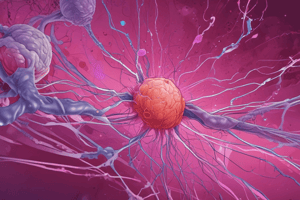Podcast
Questions and Answers
What is the common route of metastasis for carcinomas?
What is the common route of metastasis for carcinomas?
- Direct implantation
- Trans-coelomic spread
- Hematogenous route
- Lymphatic channels (correct)
Which of the following tumours is known to metastasize late?
Which of the following tumours is known to metastasize late?
- Follicular Thyroid carcinoma
- Breast carcinoma
- Melanoma
- Renal Cell Carcinoma (correct)
What is the term for the formation of new blood vessels from existing ones in tumour growth?
What is the term for the formation of new blood vessels from existing ones in tumour growth?
- Vascularisation
- Angiogenesis (correct)
- Tumour angiogenesis and stroma
- Neovascularisation
What is the characteristic microscopic feature of epithelial tumours?
What is the characteristic microscopic feature of epithelial tumours?
What is the term for the study of the shape and structure of cells in tumour diagnosis?
What is the term for the study of the shape and structure of cells in tumour diagnosis?
Which of the following is a characteristic feature of neoplastic cells?
Which of the following is a characteristic feature of neoplastic cells?
What is the term for the spread of tumour cells through body cavities and natural spaces?
What is the term for the spread of tumour cells through body cavities and natural spaces?
Which of the following is an exception to the general rule of carcinoma spread through lymphatic channels?
Which of the following is an exception to the general rule of carcinoma spread through lymphatic channels?
What is the primary way in which tumor cells spread to distant locations?
What is the primary way in which tumor cells spread to distant locations?
What is the term for the microscopic features of neoplasia?
What is the term for the microscopic features of neoplasia?
What is the role of growth factors in tumor growth?
What is the role of growth factors in tumor growth?
What is the estimated global incidence of cancer in 2030?
What is the estimated global incidence of cancer in 2030?
Which of the following is NOT a characteristic of tumor cells?
Which of the following is NOT a characteristic of tumor cells?
What is the term for the process by which tumor cells invade and destroy surrounding tissues?
What is the term for the process by which tumor cells invade and destroy surrounding tissues?
What is the leading cause of cancer mortality in developing countries?
What is the leading cause of cancer mortality in developing countries?
What is the relationship between the rate of tumor growth and the degree of differentiation?
What is the relationship between the rate of tumor growth and the degree of differentiation?
What is a characteristic of malignant tumours that distinguishes them from benign tumours?
What is a characteristic of malignant tumours that distinguishes them from benign tumours?
How do malignant tumours spread?
How do malignant tumours spread?
What is a feature of normal cells that is lost in cancer cells?
What is a feature of normal cells that is lost in cancer cells?
Why do cancer cells proliferate rapidly?
Why do cancer cells proliferate rapidly?
What is a characteristic of benign tumours?
What is a characteristic of benign tumours?
What happens to normal tissues when malignant tumours invade?
What happens to normal tissues when malignant tumours invade?
What is a way that malignant tumours can travel to distant sites?
What is a way that malignant tumours can travel to distant sites?
What is a difference between malignant and benign tumours in terms of their shape?
What is a difference between malignant and benign tumours in terms of their shape?
Flashcards are hidden until you start studying
Study Notes
Routes of Metastasis
- Lymphatic spread: common in carcinomas
- Hematogenous spread: common in sarcomas
- Spread along body cavities and natural spaces:
- Trans-coelomic spread
- Epithelium-lined surfaces
- Cerebrospinal fluid
- Implantation
- Exceptions: Cancers like RCC, HCC, and Follicular Thyroid carcinoma can spread to distant sites by hematogenous spread
Late Metastasizing Malignancies
- Renal Cell Carcinoma
- Salivary gland carcinoma
- Breast Carcinoma
- Carcinoid tumour
- Melanoma
- Granular cell tumour of the ovary
- Endometrial stromal sarcoma
Microscopic Features
- Microscopic patterns:
- Epithelial tumours: acini, sheets, columns, cords, islands
- Mesenchymal tumours: interlacing bundles, fascicles, whorls
- Histomorphology of neoplastic cells:
- Karyomegaly
- Loss of polarity
- Hyperchromatism
- Irregular nuclear margin
- Pleomorphism
- Anisonucleosis
- Increased nucleo-cytoplasmic ratio
- Tumour angiogenesis:
- Stimulation of new blood vessel formation from existing ones
Historical Background
- Cancer is not unique to humans, found in:
- Cnidaria (600 million years)
- Echinodermata (500 million years)
- Cephalopoda (500 million years)
- Amphibia (300 million years)
- Aves (150 million years)
- Never seen in Nematoda, Tradigrada, and Rotifera
Epidemiology of Cancer
- 2008 global cancer incidence: 12.7 million
- 2008 global cancer mortality: 7.6 million (21,000 deaths per day)
- 2030 predicted global cancer incidence: 21.4 million
- 2030 predicted global cancer mortality: 13.2 million
- Second leading cause of death globally (WHO)
- 70% of cancer mortality in developing countries
- Top 5 cancers in 2019: Breast, Lung, Prostate, Colorectum, and Stomach (GLOBOCAN 2020)
Characteristics of Tumours
- Rate of growth:
- Tumour cells proliferate more rapidly than normal cells
- Malignant cells grow more rapidly than benign ones
- Rate of growth dependent on degree of differentiation
- Cancer phenotype and stem cells:
- Cancer cells disobey growth controlling signals and proliferate rapidly
- Cancer cells are immortal by escaping death signals
- Cancer cells lose properties of differentiation
- Cancer cells develop newer mutations
- Cancer cells overrun neighboring cells and invade locally
Studying That Suits You
Use AI to generate personalized quizzes and flashcards to suit your learning preferences.




